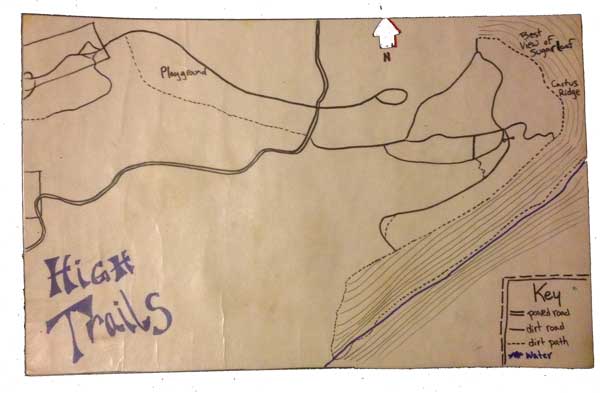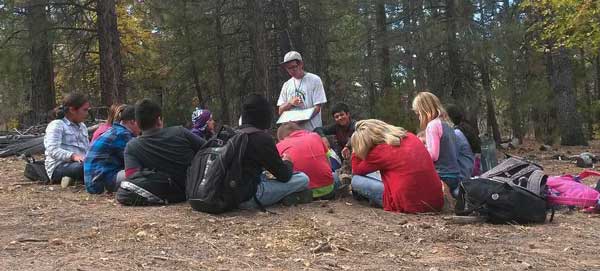Take a seat, be patient, and focus on learning some of these great classroom management techniques. Your teaching will improve (and you will be happier…).
The physical freedom in the forest isn’t something a lot of our students have experienced before. Their desire to explore and this new found freedom can often be distracting and to counter this, and keep them safe and focused, we pull from the obvious, rules and boundaries, to the creative, themes and mystery. This is how I keep their attention.
Rules and Boundaries
From my perspective, rules and boundaries as well as checking for understanding of these rules and boundaries is key. At their age, or even at my age (any age for that matter), it can be challenging to listen to a string of rules. So, as the educator, my job is to state all the rules and boundaries clearly, concisely, and in a way that can be easily remembered.
Clarity and brevity is the easy part. Being able to state your point clearly and concisely is really a way to see if the pulp of the material is fully understandable.
At High Trails, we have an acronym called N.O.I.S.E.
The challenge is stating rules and boundaries in a way that can be easily remembered.
Because they are so inquisitive and creative, I find the best way to display rules are in the context of a game. Some are easier than others to put on a creative spin; I use the style of a game show, a sports match or an auction, some sort of theme to keep them engaged.
 Having a lot of students in the forest hiking along the same trails can be a challenge. As a group, we don’t want to distract other groups or even draw attention to ourselves. We want every child to experience the solitude of the forest with their group. I play a game called Silent Tigers when we pass groups. I talk about how the tiger is a predator and in order to sneak up on its prey, it needs to be both quiet in its voice and steps. This allows students to act like tigers, thinking about how a predator hunts, and also allows us to pass other groups quietly.
Having a lot of students in the forest hiking along the same trails can be a challenge. As a group, we don’t want to distract other groups or even draw attention to ourselves. We want every child to experience the solitude of the forest with their group. I play a game called Silent Tigers when we pass groups. I talk about how the tiger is a predator and in order to sneak up on its prey, it needs to be both quiet in its voice and steps. This allows students to act like tigers, thinking about how a predator hunts, and also allows us to pass other groups quietly.
After explaining Silent Tigers during our initial class, I check for understanding of the rules the first time we play on the trail by asking the group what it means to be Silent Tigers: quiet in our voices and steps. Later, to check further understanding, I’ll stop and say we’re passing another group, what does this mean? Silent Tigers. When the understanding has been met, I will ask if someone in the group would want to be the caller for Silent Tigers for a class. Giving this responsibility, keeps the students involved and gives ownership of the group.
Sound silly? Maybe. But if you are convincing, you’ll find that this stuff WORKS.
Physical and Mental Freedom
I find keeping students focused throughout the day can be a challenge. The first class is easier to manage than the last. Students get restless both physically and mentally as the day begins to naturally wind down. So then, the challenge is keeping them as focused in that last class as they were in their first. John Dewey, educational reformer and my mentor/hero, highlights the importance of physical and mental freedom in his books.
 Students need the physical freedom of movement. They get this from the activities we do, but I think it is also important to have exploration time. This allows freedom of movement throughout the forest and allows them to explore and ask questions about different parts of the forest. They observe how the terrain and plant life is different by a water source than it is in a dry valley. They study how south and north facing ridge lines are different, making connections as to why that is. Boundaries, a reiteration of rules, as well as asking questions about things they observe allows control of that physical freedom. Then pushing to see if they can create meaning from guiding questions is an even further step you can take.
Students need the physical freedom of movement. They get this from the activities we do, but I think it is also important to have exploration time. This allows freedom of movement throughout the forest and allows them to explore and ask questions about different parts of the forest. They observe how the terrain and plant life is different by a water source than it is in a dry valley. They study how south and north facing ridge lines are different, making connections as to why that is. Boundaries, a reiteration of rules, as well as asking questions about things they observe allows control of that physical freedom. Then pushing to see if they can create meaning from guiding questions is an even further step you can take.
Along with physical freedom, students need mental freedom. They get this through reflection, silence, and a mental break from the material. During exploration time, this can be a mental freedom from the class. On the trail, between activities, is another time for this mental pause. However, it is important, too, to have time to sit in silence, seated observation or reflection. This again requires a certain amount of control, so their time for this mental freedom is productive. Providing them topics or guiding questions tracks their thinking and also allows them the solitude of mental freedom. I have found having physical and mental freedom breaks throughout the day is a good way to keep students focused.
Themes and Mystery
 Also, I believe, stringing the day as one big picture is essential in keeping students alert throughout the day. On our Environmental Days, our hiking days, I created a scavenger hunt engaging the students through all my classes..
Also, I believe, stringing the day as one big picture is essential in keeping students alert throughout the day. On our Environmental Days, our hiking days, I created a scavenger hunt engaging the students through all my classes..
The clues are written in the style from the book The Lorax by Dr. Seuss, which we perform as a play at the end of the week. Students have to guess from the clues the next class, either the name or the topic, which I told them at the beginning of the week. In addition, the second clue is our location, the map acting as a word bank. From their current position, they have to figure out the best path to take to get to that new location. The scavenger hunt allows the students to be an active part in our schedule throughout the day. Secondary, it also gives the students map skills: being able to read the legend, compass rose, location, elevation, and route logic.
 Pairing Environmental Day is Adventure Day. Courses like Rock Climbing, Archery, and the Adventure Course are common classes taught on this day. For Adventure Day, I am given the adventure box by the troll that lives under my porch. The troll tells me that everything my students need is in this box. The troll follows us around all day observing our class.
Pairing Environmental Day is Adventure Day. Courses like Rock Climbing, Archery, and the Adventure Course are common classes taught on this day. For Adventure Day, I am given the adventure box by the troll that lives under my porch. The troll tells me that everything my students need is in this box. The troll follows us around all day observing our class.
 This box has a four digit lock on it, and if the troll is happy with the students debrief of the class, then they receive a digit on the lock. As the day progresses, students crack the code and find out what is in the box. This is a simple way to keep students attentive throughout the class and is easy to refer to in order to keep the class focused. Additionally, students are more observant of the forest as they try to spot my troll friend along the trail!
This box has a four digit lock on it, and if the troll is happy with the students debrief of the class, then they receive a digit on the lock. As the day progresses, students crack the code and find out what is in the box. This is a simple way to keep students attentive throughout the class and is easy to refer to in order to keep the class focused. Additionally, students are more observant of the forest as they try to spot my troll friend along the trail!
With clear and concise rules and boundaries, a sense of physical and mental freedom, combined with a bit of mystery, I strive to keep my classes focused.
Interested what’s in the adventure box? You might just have to come to High Trails to find out.
At High Trails Outdoor Science School, we literally force our instructors to write about elementary outdoor education, teaching outside, learning outside, our dirty classroom (the forest…gosh), environmental science, outdoor science, and all other tree hugging student and kid loving things that keep us engaged, passionate, driven, loving our job, digging our life, and spreading the word to anyone whose attention we can hold for long enough to actually make it through reading this entire sentence. Whew…. www.dirtyclassroom.com



Comments are closed.